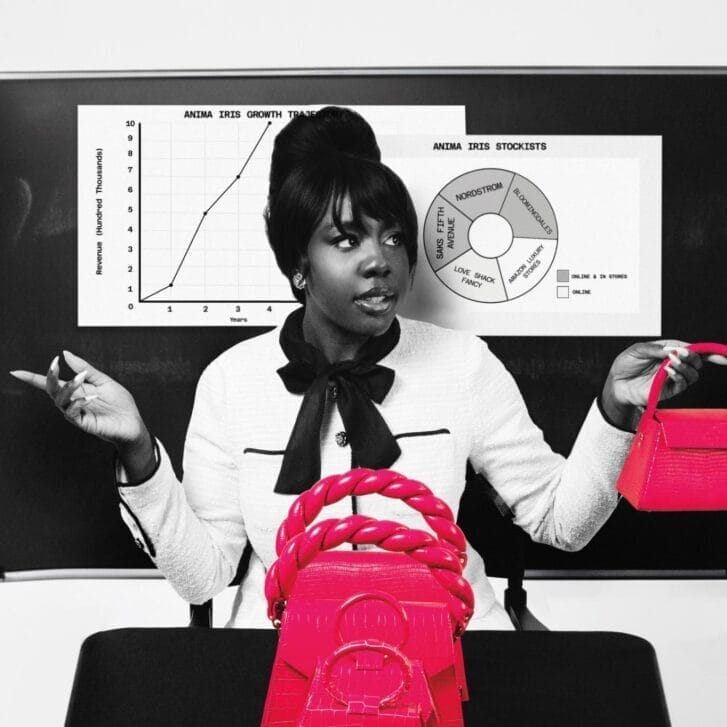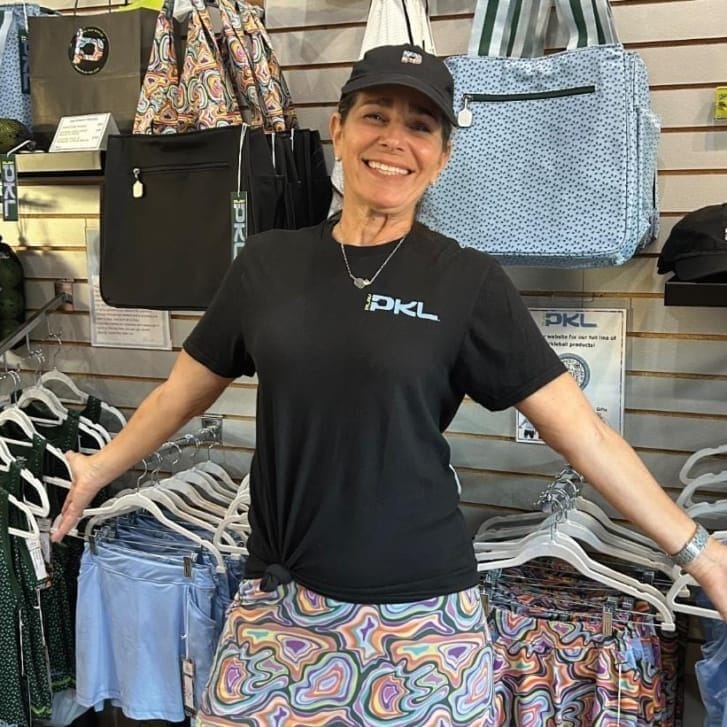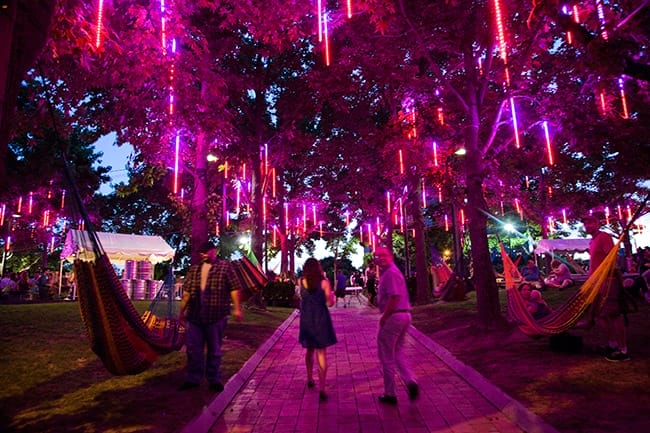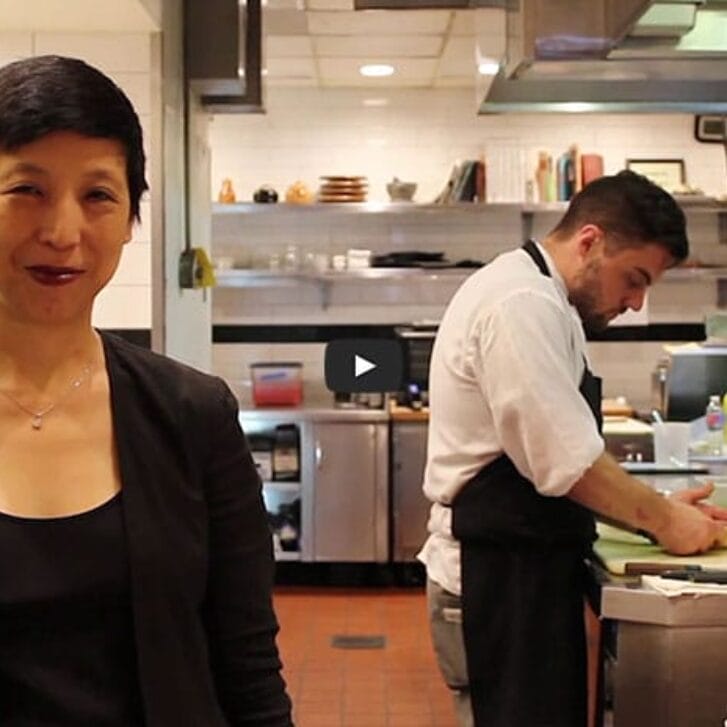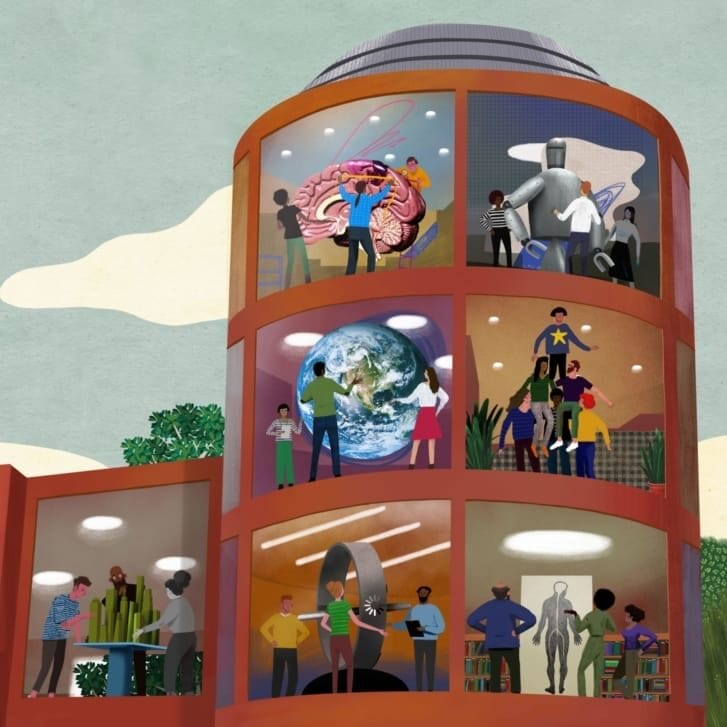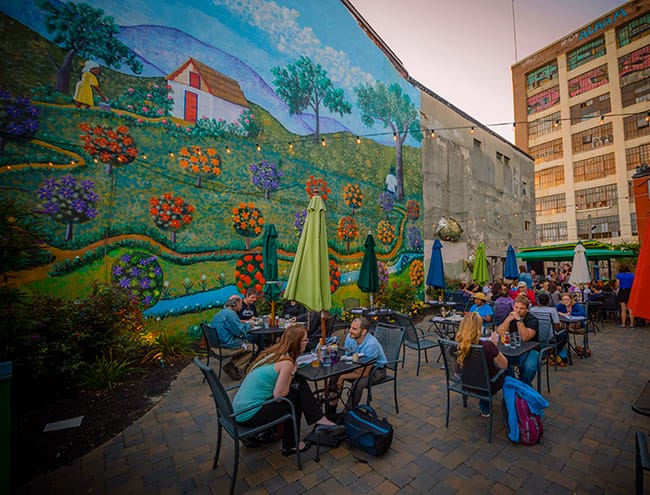
Philadelphians enjoy alfresco dining at every opportunity, at this case at Llama Tooth … Photo credit: M. Kennedy for Visit Philadelphia/GPTMC.
Step aside, Boston, New York and the Bay Area.
Here comes Philadelphia. Philly is hot—once again.
From cutting-edge research anchored by world-class institutions to rapidly transforming “greenways,” to an unrivaled restaurant and brewery scene, Philadelphia is in the midst of a transformation, if not all-out rebirth.
“We’re absolutely in the midst of a Renaissance,” says Matthew Bergheiser WG96, executive director of the University City District (UCD). “I moved to Philadelphia in 1994 for Wharton and the best restaurant on Rittenhouse Square was a Houlihan’s.”
Stroll through the square today and restaurants around the green go by names like Parc Brasserie and the Devon Seafood Grill—and that’s not all.
Courtney Graybill WG11, senior director of strategy and process improvement for David’s Bridal and a graduate of the Wharton MBA for Executives Program, marvels how children and parents pack Rittenhouse Square on weekends.
“I don’t think I would have said the same thing 15 years ago,” says Graybill, a native of Macungie, Pennsylvania.
Philly, home to top-tier museums and a vibrant entrepreneurial scene, headquarters to some of the nation’s most powerful companies and a world-class educationalmedical complex, wouldn’t be lying if it were to swipe a line from a Staples commercial and claim, “Yeah, we’ve got that.”
The cliché of Philadelphia as an aging, grimy urban metropolis is as outdated as the image of underdog pugilist Rocky Balboa, fists clenched under leaden skies, in search of an escape from a dead-end life.
Whether tourists stroll through the cobblestones for a glimpse of history, food critics clamor for a table at its restaurants or planners eye its transformation into a progressive model for urban living, boosters feel an unmistakable momentum building.
“It’s snowballing in a really positive way,” says Heather Aspras WG08, president of the 400-member Wharton Alumni Club of Philadelphia and a Pitman, New Jersey, native.
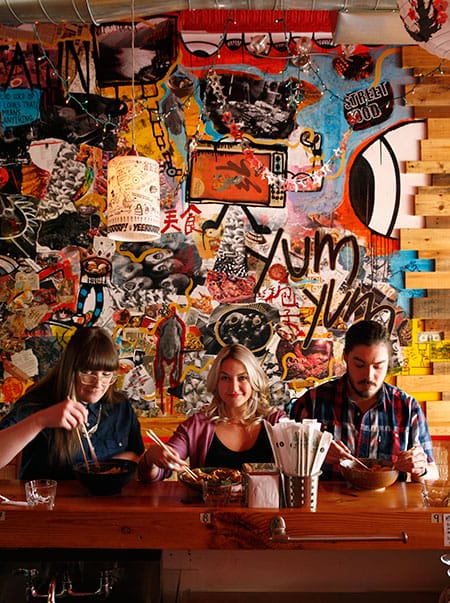
… or indoors as well, here at Cheu Noodle Bar. Photo credit: Jason Varney.
DISTRICTS OF INNOVATION
One of the hottest areas in Philadelphia is actually outside of Center City—five miles south down Broad Street. The 1,200-acre Navy Yard at the confluence of the Schuylkill and Delaware rivers is shaping up into a textbook example of how to redevelop an old industrial site formerly run by the U.S. military. More than 11,000 employees and 145 companies work within the borders of the Navy Yard, according to planning documents, helping to reestablish the site as a major center of economic activity. Complete with parks, boulevards and a port, the mixed-use site forges new paths in melding industry, hightechnology, manufacturing and corporate administration. Top-tier tenants include Urban Outfitters and pharmaceutical giant GlaxoSmithKline PLC, and the U.S. Navy recently announced plans to expand its engineering, office, and research and development on the site.
Then again, members of the Penn community don’t have to travel even that far to be immersed in innovation. Stand at the intersection of Market Street and the Schuylkill River, look west toward the heart of University City, and there’s no mistaking the cranes, the jarring jackhammers and the beeping of construction vehicles in reverse—bringing a distinctly blue-collar vibe to neighborhoods teeming with brilliant minds.

The Comcast Center stands tallest in the city skyline, with the new over-the-water Schuylkill Banks Boardwalk in the foreground. Photo credit: M. Edlow for Visit Philadelphia/GPTMC.
In the past five years, 10 million square feet of real estate projects have been developed within the 1,534 acres that comprise UCD, according to the district’s most recent annual report.
At 3700 Hamilton Walk, the University of Pennsylvania’s renovation of 14,140 square feet in Towers C and D of the Richards Medical Research Laboratories designed by Louis I. Kahn are slated for completion this spring. Around the corner, at the intersection of University Avenue, 38th Street and Baltimore Avenue, Penn’s 76,500-squarefoot Neural and Behavioral Sciences Building is on track to open in the spring of 2016.
Outside of the gleaming facades, Penn students, sometimes side by side with Drexel students, toil feverishly in hopes of launching the next Facebook or Uber. Dorm rooms and coffee shops have supplanted the traditional garage as the place “where it all started.” Fueled by the “spillover” factor from the universities and adjoining hospitals and medical research—juggernauts of the medical-education complex teeming with “accelerator” programs—the city and region benefit.

Commuters enjoy a moment off their feet in one of Philadelphia’s pop-up parks, this one in the University City District . Photo credit: University City District.
“I think there are some really bold efforts at Penn and some newer efforts at other institutions,” Bergheiser says. “That’s where we need to go: ‘eds and meds.’”
Avid Radiopharmaceuticals Inc., a molecular imaging company founded in 2004 by Dr. Daniel M. Skovronsky GR00 M01, a former resident in pathology at the Hospital of the University of Pennsylvania, was acquired in 2010 by Eli Lilly & Co. for $800 million—$300 million upfront and another $500 million based on the company’s performance. Avid is now a wholly owned subsidiary of Eli Lilly.
Gene therapy company Spark Therapeutics, born out of the Children’s Hospital of Philadelphia (CHOP), closed its initial public offering of more than 8 million shares Feb. 4. “We need 10 of those,” Bergheiser says.
N3RD STREET AND BEYOND
Students aren’t the only ones taking advantage of the growing opportunities. With the financial crisis and the shift in the Wharton School’s emphasis toward entrepreneurship, alumni are expressing more interest in staying in Philly after graduation, says Aspras, a marketing director at GlaxoSmithKline.
Millennials appear to be embracing such locales as the UCD and the Navy Yard because they represent a new urban model, as explained by Brookings Institution researchers Bruce Katz and Julie Wagner in a report published this past May. Innovation districts “focus on the creation of “a dynamic physical realm that strengthens proximity and knowledge spillovers,” the researchers write. People in their 20s prefer to live, work and play in an integrated space, and Philadelphia, with its cluster of walkable neighborhoods and parishes, offers the kind of intellectual, commercial and social ferment sought by young college graduates.
And right now, reality is proving the hypothesis correct; the city is attracting the young. The population of 20- to 34-yearolds increased by about 100,000 from 2006 through 2012, according to U.S. Census Bureau estimates cited in a January 2014 report on Philadelphia millennials published by the Pew Charitable Trusts.
Vikram Dewan WG78, president and CEO of the Philadelphia Zoo, which attracts more than 1.3 million visitors annually, says Philadelphia has always been “a city of neighborhoods.”
“That’s where the energy, the enthusiasm and the identity [are], and the way people relate to each other,” he says.
What may be different today, however, is that the energy and neighborhoods come with a startup ecosystem.
Listen to the reasons cited by Carlos Vega C03 WG14, CEO and founder of the financial technology startup Tesorio, for why he chose Philadelphia.
“Philly offers a tight-knit, underdog tech scene where investors, entrepreneurs and the government are aligned by a collective goal of the community’s success,” Vega says. “Community is very important to me. Affordability, proximity to large corporate headquarters and a pool of talent at local schools sealed the deal.”
In Philadelphia, Vega made connections that helped him launch his company, including financing from the StartupPHL Angel Fund, managed by Philadelphia-based investor Josh Kopelman W93, and the Philadelphia Industrial Development Corp.
In the meantime, downtown, midtown, Old City, University City and the neighborhoods farther afield teem with new startup blood. Last year, the section of North 3rd Street slicing through Old City and Northern Liberties was renamed N3rd Street (pronounced “nerd”), to recognize the frenzy of startup activity working along the narrow street—a sure sign that the city takes its entrepreneurialism seriously. By one count, more than 30 startups and 45 design firms are packed in the stretch.
The most accurate estimate of the number of technology companies, startups included, within the city’s 135-squaremile boundary pegs the total at about 488, according to a January 2014 posting by Technical.ly Philly. Bergheiser estimates the number of UCD startups at 97.
From a historical perspective, Philadelphia—which in February was picked to host the 2016 Democratic convention— has always surged with big, innovative ideas.
Recall that the city served as the meeting place for the boldest public “startup” of them all: the Continental Congress, which first met in Carpenters’ Hall in 1774.
Founded in Philadelphia in 1963 with the purchase of a Mississippi cable system and now a conglomerate boasting $68.7 billion in revenue, Comcast Corp. broke ground last year for a second high-rise in Center City to serve as the company’s headquarters for innovation, engineering and product development. Designed by Foster + Partners, the new 59-story mixed-use tower, the Comcast Innovation and Technology Center, will soar 1,121 feet into the sky, eclipsing the city’s current tallest building, the 58-story, 975-foot Comcast Center.
Sam Schwartz EE85 WG90, chief business development officer for Comcast, says Philadelphia has been a startup city for the last 250 years, let alone the last 20.
“In the last 15 years, education and medicine have been a big piece of what has fueled the startup scene in the city and the region,” says Schwartz, who recruits technical talent to the region from around the country.
The new building will house technologists and software architects and will become the new home to NBC 10/WCAU and Telemundo 62/WWSI. Architect Lord Norman Foster says the loft-like spaces and studios planned for the new building are designed to create an open, dynamic working environment preferred by today’s entrepreneurs.
Besides Comcast’s premium sponsorship of Philly Tech Week, the media and technology giant hosts dozens of technology meetings and user groups and sponsors summer work programs for college students who have left the region in hopes of luring them back to the city after they graduate.
“I’ve been an entrepreneur and a venture capitalist in the city, and we’re really trying to do what we can to see the city thrive in this way,” Schwartz says.
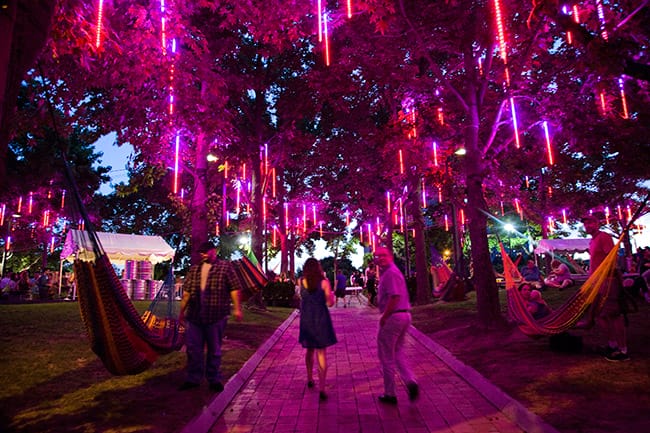
Another pop-up park, Spruce Street Harbor Park. Photo credit: M. Edlow for Visit Philadelphia/GPTMC.
POPPING-UP PARKS
“When I went to Wharton, many people were excited about being at Wharton but they weren’t so excited about Philly,” Aspras says. Now, she says, she’s more excited than ever to live in Philly. Part of the reason is that Philly is becoming an outdoor mecca more than ever.
On the western bank of the Delaware River, east of Old City, lies much of Philadelphia’s potential to attract a “mass audience” of day-trippers, downtown residents and out-of-town tourists. There, the tide of redevelopment washes over the riverfront with each passing season. “Connector streets,” linking Old City with the waterfront, have been softened with an infusion of green, drawing residents and visitors to a lush, active and vibrant waterfront. Once a quasi-barren landscape dominated by warehouses, parking lots and dilapidated piers, developers have reimagined the waterfront as a destination packed with summer and winter festivals.
Starting with the redesign of Race Street pier in 2011, the new landscape is taking shape between the soaring suspension spans of the Ben Franklin and Walt Whitman bridges as one by one, piers rise anew from the depths of neglect.
The Blue Cross RiverRink Winterfest at Penn’s Landing draws thousands of residents and visitors despite bitter chills. The winterfest, lit up by holiday lights, is geared to family activities that include ice skating, shopping, food and cocktails in a winter lodge with fireplaces. Designers have lined the skating rink with trees to create a forest atmosphere around the winter garden. Winterfest lasts from November to March.
In the summer, Spruce Street Harbor Park pops up in the same location. Three barges, each measuring 80 feet by 30 feet, were floated down the river last June to form the kernel of an “oasis,” the centerpiece for Spruce Street Harbor Park. Around the oasis, planners created lounging areas with hammocks and an urban beach and boardwalk.
Philadelphia Live Arts Festival is in the process of redeveloping the historical pumping station across from the Race Street pier for theater, offices and a restaurant.
Dewan, who runs the Zoo located within the borders of Fairmount Park, billed as the “world’s largest landscaped city park,” says open spaces and parks are vital to the well-being of city residents. It’s important to create a quality of life and generate new opportunities for people to want to stay, particularly the best and the brightest who can relocate anywhere in the world, he says. Dewan also doesn’t want you to forget: Philadelphia already has one of the largest urban park systems in the country, a network that’s about to get even bigger as city planners integrate and rehabilitate open spaces and stitch yet more greenery into the city’s fabric.
Plans call for a park every half-mile along the Delaware riverfront, for example, which will be connected by trails to “The Circuit,” 750 miles of walking and biking trails throughout the region—300 miles of which have already been built.
Urban planners have even found a way for people to “walk on water” along the meandering Schuylkill River Boardwalk.
In January, The New York Times travel editors voted Philadelphia the No. 3 destination in 2015, after the northern Italian city of Milan and Cuba, and just ahead of Yellowstone National Park.
With seasonal “pop-up” parks and beer gardens sprouting on formerly abandoned lots, giving life to where there was none before, the city, writes Nell McShane Wulfhart in the Times, has become “a hive of outdoor urban activity.”
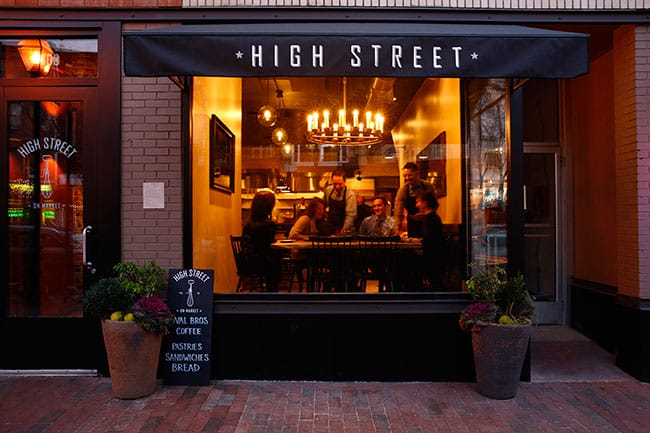
Ellen Yin’s High Street, located on Market Street next door to her mainstay of the Philadelphia food scene, Fork. Photo credit: Jason Varney.
RESTAURANTS IN THE ’HOODS
Travel + Leisure magazine’s January 2015 issue devotes a page to the city’s dining scene and calls Philadelphia “America’s Next Great Food City.”
New Jersey native Ellen Yin WG93, co-founder of Fork and High Street on Market, tips her glass to the quality of life in the city. It’s always been very good, she says, and has only improved since.
When Yin opened Fork in 1997, “We were thinking we weren’t going to be anything but a local neighborhood restaurant,” Yin says. But after rave reviews in Philadelphia magazine and USA Today, the eatery became a destination restaurant.
Now Philadelphia’s entire restaurant and brewery scene has become a national destination.
“There’s a lot of room for growth in the city right now,” says Yin, who can name several classmates who launched their own businesses in the region, including Brad Korman WG92, co-CEO of real estate company Korman Communities; Linda Farquhar WG93, founder of entreDonovan, a custom clothing line for professional women; and Leslie Benoliel WG91, executive director of Entrepreneurship Works.

Even the yogurt at High Street looks out of this world. Photo credit: Jason Varney
Aspras says that the explosion of the city’s restaurant and beer scene in the past 15 years has brought a more progressive vibe to downtown as young restaurateurs cater to more adventurous palates beyond cheesesteaks and Italian hoagies.
Residents don’t have to walk far to find a good restaurant, then walk some more in search of another eatery that’s just as good, she says.
If Philadelphia is “riding a market wave,” says Bergheiser, the seeds of the city’s rebirth were planted more than 20 years ago under former mayor Ed Rendell. “Rendell believed you needed someone to help shepherd the business through the bureaucracy,” Yin agrees.
Current Mayor Michael Nutter W79 has continued in the same vein. Not only has the city approached local and regional planning in a more coordinated way, the administration has embraced entrepreneurship by fast-tracking projects and cutting red tape.
“As you walk down South Street between Broad and 17th, it used to be a dead zone, and now you walk there and it’s full of bars, restaurants and small business that have popped up,” says Graybill, who has lived downtown for the past eight years.
Just as former city leaders helped lay the groundwork for what the city has become, today’s leaders are planning for what they hope will be 20 years from now: a region powered by what economists call the “virtuous cycle” of growth, when large companies buy fledgling enterprises, leaving the startups’ founders to reinvest money from the sale into new ventures.
With a surfeit of universities and medical research, leaders receptive to entrepreneurship and a relatively high quality of life, Philadelphia is primed for that “wheels up” moment when the virtuous cycle lifts off.
“It feels to me now that we’re definitely on an upward trend,” Schwartz says.
—Cyril Tuohy is a Philly-based journalist who has been writing about business for three decades.






